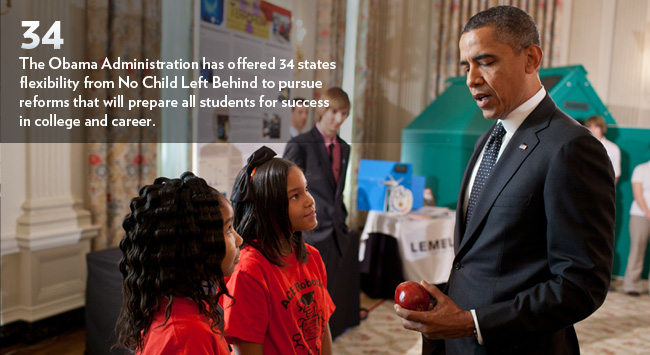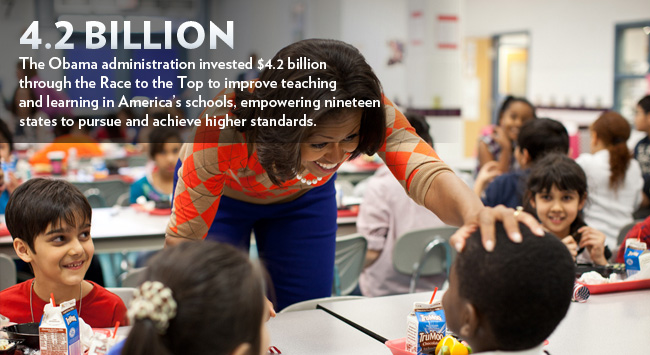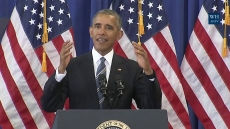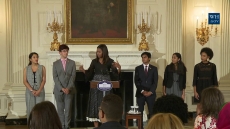EDUCATION
“If we want America to lead in the 21st century, nothing is more important than giving everyone the best education possible — from the day they start preschool to the day they start their career.”
Reforming No Child Left Behind
As states move forward with education reforms, some provisions of No Child Left Behind—the most current version of the Elementary and Secondary Education Act—stand in the way of their progress. Although NCLB started a national conversation about student achievement, unintended consequences of NCLB have reinforced the wrong behaviors in attempting to strengthen public education. NCLB has created incentives for states to lower their standards; emphasized punishing failure over rewarding success; focused on absolute scores, rather than recognizing growth and progress; and prescribed a pass-fail, one-size-fits-all series of interventions for schools that miss their goals.
Blueprint for Reform
The President has called on Congress to work across the aisle to fix the law even as his Administration offers solutions for states to help prepare all students for college and career readiness. In March of 2010, the Obama Administration sent to Congress a Blueprint for Reform of the Elementary and Secondary Education Act, addressing the issues created by No Child Left Behind, while continuing to shine a bright light on closing the achievement gap.
Under the Administration's blueprint for ESEA reauthorization, state accountability systems will set a high bar of all students graduating from high school ready to succeed in college and careers. The accountability system also will recognize and reward high-poverty schools and districts that are showing improvement in getting their students on the path to success, using measures of progress and growth. States and districts will continue to focus on the achievement gap by identifying and intervening in schools that are persistently failing to close those gaps. For other schools, states and districts would have flexibility to determine appropriate improvement and support options.
The blueprint asks states and districts to develop meaningful ways of measuring teacher and principal effectiveness in order to provide better support for educators, enhance the profession through recognizing and rewarding excellence, and ensure that every classroom has a great teacher and every school has a great principal.
No Child Left Behind Waivers
Because Congress would not act to reauthorize ESEA, the Administration moved forward to offer states flexibility within the law – as authorized by provisions in the law itself – to pursue comprehensive plans to improve educational outcomes for all students, close achievement gaps, and improve the quality of teaching. This ESEA flexibility will let states, schools, and teachers develop and implement effective ways to give our children the skills they need to compete for the jobs of the future, while maintaining a high bar for the success of all students.
To receive flexibility from NCLB, states must adopt and have a strong plan to implement college- and career-ready standards. States must also create comprehensive systems of teacher and principal development, evaluation and support that include factors beyond test scores, such as principal observation, peer review, student work, or parent and student feedback. States receiving waivers must set new performance targets to improve student achievement and close achievement gaps.
States receiving flexibility also must implement accountability systems that recognize and reward high-performing schools and those that are making significant gains, while targeting rigorous and comprehensive interventions for the lowest-performing schools and schools with the largest achievement gaps. Under the new state-developed accountability systems, all schools will develop and implement plans for improving educational outcomes for underperforming subgroups of students. Unlike the one-size-fits-all interventions imposed by No Child Left Behind, states and districts can design improvement strategies and allocate federal resources in ways that best meet the needs of their schools and students, while maintaining continued transparency on student performance and achievement gaps.
To date, 41 States, CORE (California Office to Reform Education) Districts, and the District of Columbia are approved for ESEA flexibility. The states that have been awarded flexibility from No Child Left Behind include: Alaska, Alabama, Arizona, Arkansas, California CORE Districts, Colorado, Connecticut, Delaware, District of Columbia, Florida, Georgia, Idaho, Indiana, Kansas, Hawaii, Kentucky, Louisiana, Maine, Maryland, Massachusetts, Michigan, Minnesota, Mississippi, Missouri, New Jersey, New Hampshire, New Mexico, New York, Nevada, North Carolina, Ohio, Oklahoma, Oregon, Pennsylvania, Rhode Island, South Carolina, South Dakota, Tennessee, Utah, Virginia, Washington, West Virginia, and Wisconsin.






